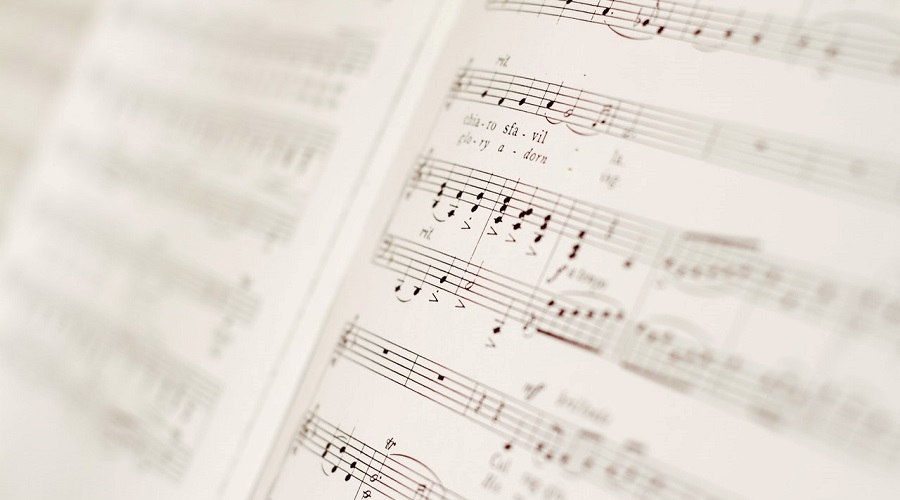In music class, the staff is among the first things students learn. It’s the very foundation of music notation, often thought of as a musical graph to indicate a note’s pitch. Without it, it’ll be extremely difficult to read music.
This article discusses everything you need to know about the staff. What is a staff in music, and how did it come to be? Let’s find out!
What Is a Staff in Music?
Simply, the staff (or “stave,” as more commonly known in the UK) is a musical version of a mathematical graph, consisting of five lines and four spaces.
Each space and line represents a different musical pitch, which corresponds to one of the keys on the selected instrument.
History of Musical Staff
Early manuscripts show that musical notation was first practiced by Ancient Egyptians in 3000 BC. Ancient Greece, as well as China and Japan, more or less followed the same system.
Musicians used early versions of neumes instead of staves, arranging notes around one or two lines to make the composition easier to time. This indicates that neumes served as a timescale reminder rather than a method to read music through sight.
9th Century

According to scholars, the staff was “officially” invented by Italian music theorist Guido d’Arezzo in the 9th century (AD 990–1050).
He introduced the staff as a way to address issues of musical pitch. Originally, his staff consisted of a single horizontal line. As musical compositions became more complex, he added four additional parallel lines to the staff.
Similar to the staff we use today, the vertical positions of each mark represented pitch. His four-lined staff is still used to this day, primarily in Gregorian chant publications.
13th Century
The universal five-line staff first appeared in 13th century Italy, promoted by Italian composer and musical theorist Ugolino da Forlì. The composition of complex polyphonic works was made possible thanks to the early five-line staff.
16th Century
By the 16th century, staves with four, five, and six lines were widely used. The clef was invented shortly after to indicate the pitch and order of notes on a staff. The clef represented the tones G, F, and C, hence their names—G-clef, F-clef, and C-clef.
How Does the Staff in Music Notation Work?
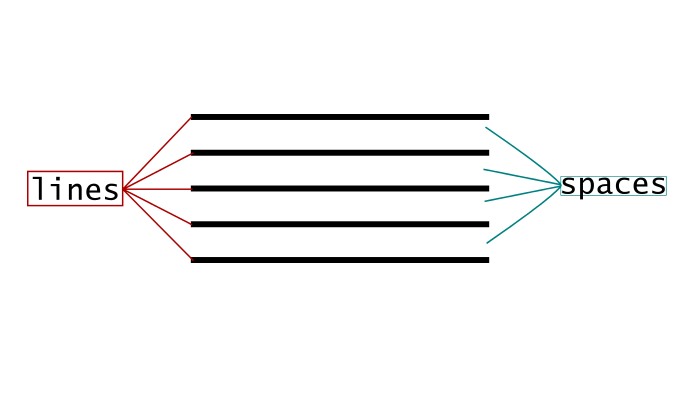
The staff is an essential part of musical notation. Each line or space on the staff represents a certain pitch, which is indicated by the placement of a clef symbol.
Percussion staves are the only exception to this rule, simply because they don’t usually come with multiple pitch selections. In a percussive staff, each line or space indicates a certain percussive instrument.
The lines and spaces are numbered from bottom to top; the top line is the fifth line and the bottom line is the first line. The time signature sitting on the right of the clef indicates the relationship between note symbols and timing counts.
Barlines group the notes on the staff into measures. When a dot is placed to the right of a note head, the duration increases by half of that note. These symbols, when placed, indicate two different things: relative pitch and relative duration.
The grid lines represent the note’s alternative scales, as well as any other intervening notes in between the spaces.
What Is the Grand Staff?
The grand staff is the most commonly known and recognized staff in piano music. It’s a two-part staff used to accommodate the wide range of notes found on the piano.
Typically, the top treble staff and the bottom treble staff are joined by a brace. The brace indicates that the connected staves function as an individual unit.
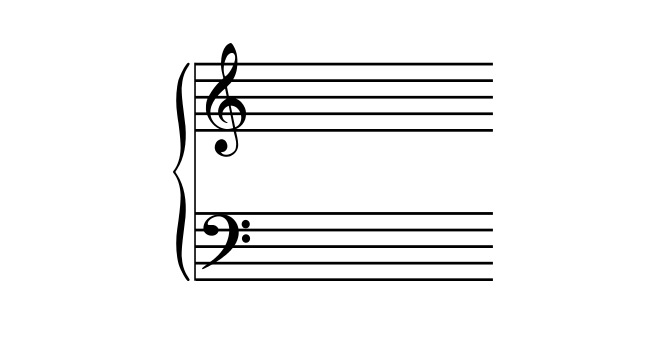
This symbol is especially common in piano music, splitting the grand staff between the right and left hand. Lower notes on the bass staff (F-clef) are played with a pianist’s left hand. Higher notes on the treble staff (G-clef) are played by the right hand.
Barlines also appear on the grand staff. Similar to the brace, bar lines indicate the staves should be played as one musical unit rather than two separate units.
All in all, the grand staff merges two staves with two separate clefs, resulting in a wider range of pitches available to the pianist.
Clefs on Other Staves and Musical Instruments
The staff isn’t only limited to the G-clef and F-clef. Other clefs may also be used to indicate a change of pitch in a particular line or space.
Treble Staff
The treble clef on a musical staff is primarily used in harp and keyboard instruments. If used in conjunction with the tenor clef, the treble clef is also used for the highest notes for the cello, trombone, double bass, and bassoon.
On the second line of the staff, where the G-clef is placed, the middle line is a “B” above the middle C. From top to bottom, the lines on the treble staff are E, G, B, D, F (mnemonic: Every Good Boy Does Fine). The spaces are F, A, C, E.
Bass Staff
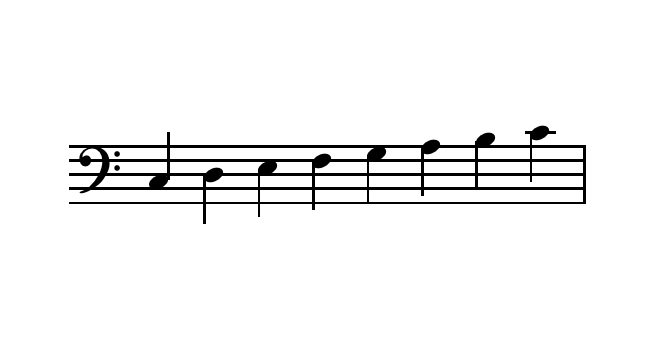
The bass clef is commonly used for the double bass, guitar, bassoon, cello, trombone, timpani, and tuba. When parts are written at concert pitch, the bass staff is used for the baritone horn or euphonium. The bass staff is the only F-clef used today.
On the fourth line of the staff, where the F-clef is placed, the middle “D” is below the middle C. From top to bottom, the lines on the bass staff are G, B, D, F, A (George Bush Died Friday Afternoon). The spaces are A, C, E, G (All Cows Eat Grass).
Alto Staff
The alto clef, also known as the viola clef, is generally only used for the viola and the alto trombone.
On the middle line of the staff, where the C-clef is placed, the middle line of the alto staff is the middle C. From top to bottom, the lines on the bass staff are F, A, C, E, G. The spaces are G, B, D, F.
Tenor Staff
The tenor clef is occasionally used to represent an instrument’s upper range, particularly the double bass, trombone, cello, and bassoon.
The tenor clef shares the same symbol of the alto clef but is moved higher on the staff. Similarly, C has moved up a single line from the alto clef.
On the fourth line of the staff, where the C-clef places, the fourth line of the tenor clef is a middle C. From top to bottom, the lines on the bass staff are D, F, A, C, E. The spaces are E, G, B, D.
Major Components of the Staff
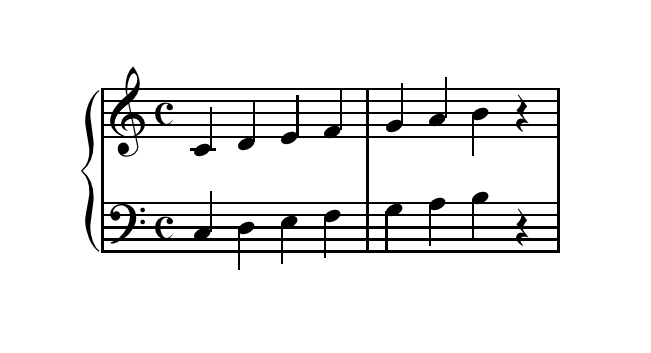
The staff consists of several components found in almost every composition. These are as follows:
Staff
The staff indicates the framework of music, including pitch, dynamics, duration, etc.
To differentiate musical measures, bar lines run perpendicular to the staff.
Single bar lines, for instance, separates one musical measure from another. Double bar lines separate sections within a music piece. Bold double bar lines either signified the end of an entire piece or the end of a musical movement.
Brace
The brace connects two staves with different clefs, forming a grand staff.
Bracket
The bracket connects multiple staffs with different clefs into a single system. However, unlike the brace, the bracket tells the player that multiple different instruments should be playing on the different staffs, rather than just the pianist’s right and left hands.
Clef
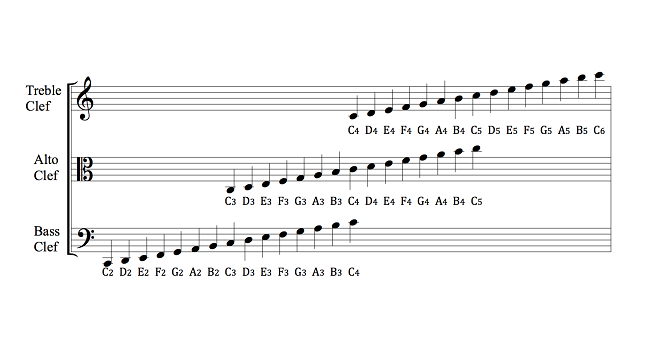
The clef indicates the different notes and pitches represented by the given vertical notes on the staff.
Notes
When written in sheet music, note values that differ in length are depicted in various ways.
Some of the most common note values include:
- Whole note: full duration of a four-beat measure
- Half-note: half of a four-beat measure
- Quarter note: one-quarter of a four-beat measure
- Eighth note: one-eighth of a four-beat measure
- Sixteenth note: one-sixteenth of a four-beat measure
Smaller subdivisions, like 32nd notes, 64th notes, and even 128th, rarely appear in a musical staff. This is primarily because composers find it easier to set tempos rather than note values, removing the need for durations shorter than a sixteenth note.
Accidentals
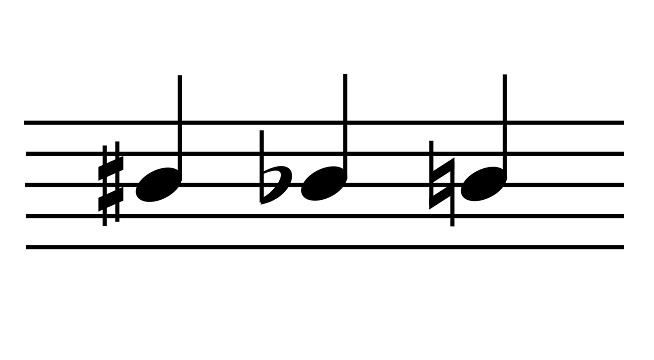
An accidental is a note whose pitch isn’t a member of the original key signature. In Western music, accidentals allow up to 12 music notes to appear on a staff. Some of the most common accidentals include the following:
- Sharp (♯): indicates that a note should be played half a step higher than the original pitch of the staff.
- Flat (♭): the opposite of sharp; indicates that a note should be played half a step lower than the original pitch of the staff.
- Double sharp (���): indicates that a note should be played a whole step higher than the pitch of the staff.
- Double flat (���): the opposite of double sharp; indicates that a note should be played a whole step lower than the pitch of the staff.
- Natural (♮): indicates that the note should be played naturally, disregarding all previously indicated accidentals.
Time Signatures
Time signatures indicate the composition’s rhythmic duration. They provide players two critical information:
- Duration of each beat in a measure
- Number of beats per measure
In Western music, the most common time signature is 4/4, indicating four quarter-notes per measure. As they’re used in the majority of musical compositions, the 4/4-time signature is often dubbed “common time” or simply “c.”
The 3/4-time signature invokes a certain waltz feel. It indicates three beats per measure, with each beat a quarter-note long. The 6/8-time signature indicates six beats per measure, with each beat following an eighth note.
Ledger Line
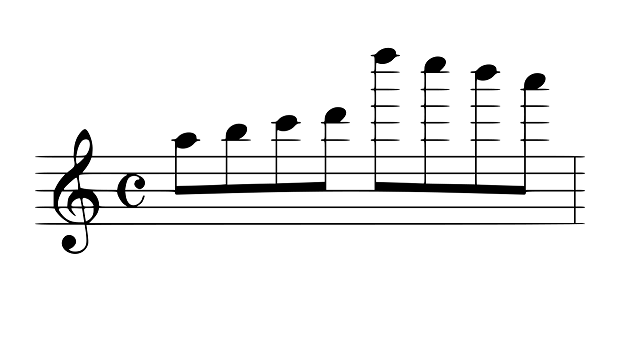
If the staff doesn’t have enough room for really high or really low notes, ledger lines come to the rescue.
Ledger lines are short, horizontal lines added above or below the regular music staff, further extending its range.
Whenever you see ledger lines, all you have to do is count up. Typically, each line is two notes higher than the note below it. The space is only one note higher.
Dynamic Markings
Dynamic markings dictate the loudness or softness between notes or phrases. The execution of dynamics often includes changes in timbre or tempo rubato.
In Western music, the most basic and common dynamic indications are “p” or piano, meaning quiet, and “f” or forte, meaning strong or loud.
Other dynamic degrees include the following:
- mp (mezzo-piano): moderately quiet
- mf (mezzo-forte): moderately loud
- più p (più piano): more quiet
- più f(più forte): more loud
- pp(pianissimo): very quiet
- ppp (pianississimo): very, very quiet
- ff (fortissimo): very loud
- fff (fortississimo): very, very loud
How Is Staff Used in Unpitched Percussion Instruments?

Apart from the typical 5-line staff, 1-line, 2-line, and 3-line staves also exist. These staves are primarily used for untuned percussion instruments that don’t come with different musical pitches.
This includes drums, cajons, cymbals, and a wide range of other hand-held instruments
In certain circumstances, untuned percussion instruments use a regular 5-line staff rather than a special percussion staff.
If this occurs, the staff’s lines and spaces don’t represent pitch, simply because they don’t have pitches. In its place, each line or space represents a beating spot, technique, or percussion instrument.
What Are Courtesy Signs in Musical Staff?
Courtesy signs in the musical staff make it easier for the performer to interpret and read particularly complex music notations. Usually, courtesy signs are provided by the editor or composer to assist the performer with quick compositional changes.
These signs can show a number of changes, including changes in the key signature, time signature, clef, and accidentals.
To help musicians change rhythm and pitch in time, courtesy signs are typically placed at the end of musical measure. This allows them to promptly adjust their chord progressions in the upcoming measure or staff.
However, they can also be shown at any point of the composition, particularly when a note is changed.
Clefs, time signatures, and key signatures are usually placed after the staff’s final bar line. Accidentals appear in front of the notes and are often enclosed in parentheses marks.


